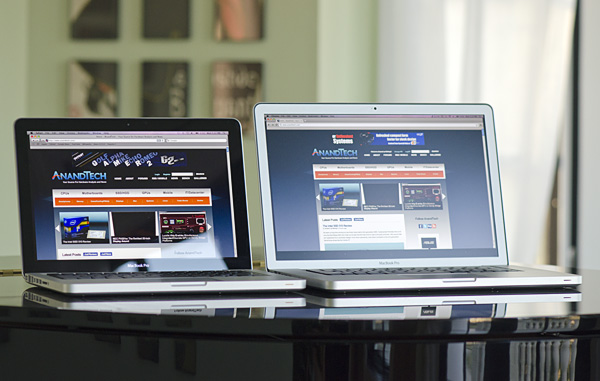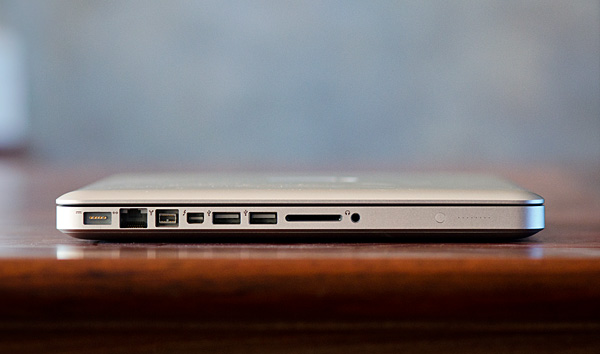The MacBook Pro Review (13 & 15-inch): 2011 Brings Sandy Bridge
by Anand Lal Shimpi, Brian Klug & Vivek Gowri on March 10, 2011 4:17 PM EST- Posted in
- Laptops
- Mac
- Apple
- Intel
- MacBook Pro
- Sandy Bridge
Final Words
For as little attention as the 2011 MacBook Pro launch was given by Apple, there sure is a lot to talk about.
The advantages are numerous. With the 13-inch MacBook Pro, under OS X at least, there simply aren't any downsides. You get much better CPU performance over the previous generation. In fact, the new 13 can outperform last year's 15 thanks to Sandy Bridge. The new 13 is quite possibly the best balance of portability and performance. It's the single largest upgrade you'll find in the lineup. If you own a previous generation 13-inch MBP, the upgrade is 100% worth it. Graphics performance is solid under OS X however questionable under Windows. For some reason we actually saw a step back in GPU performance vs. last year's 13-inch MBP when running games in Windows 7.
The 15-inch MacBook Pro is a beast. Although it comes in the same chassis as last year's model, it delivers much more performance. The move to quad-core Sandy Bridge makes the 15-inch MacBook Pro's performance formidable. Whereas I couldn't use the 2010 15 as my primary work machine, with an SSD the 2011 15-inch MBP does just fine.
Displays haven't really changed, which is both good and bad. On the one hand, Apple's MacBook Pros have always used good quality panels. On the other hand I'd like to see a higher res option for the 13-inch display—1280 x 800 is a big turnoff for me with the 13-inch model.
Thunderbolt is a nice addition however I expect that it'll be grossly underused for a while. We'll see some nice Thunderbolt enabled external storage solutions this Spring (helping perpetuate the mobile desktop usage model), but it'll be a while before we get the single-cable carrying USB, Ethernet, FireWire and DisplayPort to a display.
The WiFi improvements are welcome, although surprisingly absent from Apple's marketing collateral. The front facing 720p camera is also a nice touch.
It's not all rosy however. Apple fails to really take advantage of one of Sandy Bridge's biggest features: Quick Sync. The hardware encoder is used in FaceTime HD but you still get some very high CPU usage (at least of a single core). There's no support in QuickTime or iMovie 2011 for Quick Sync as of now, which is a major disappointment.
I mentioned that the 15-inch MacBook Pro is easily a desktop replacement, however you do have to deal with a loud fan under heavier CPU loads. Something a well designed desktop won't bother you with.
SSD support is still problematic. There are far too many reports of drives that don't work properly in the 2011 MacBook Pro, and Apple refuses to validate/ship anything but fairly mainstream SSD solutions. To make matters worse, although TRIM is finally enabled under OS X—it only works on Apple branded SSDs. I can understand Apple's desire to want to avoid dealing with the pitfalls of early SSDs with questionable firmware maturity, but I also believe it's Apple's duty to support as much hardware that's out there in the market today. If Apple offered something with SandForce SF-2200 class performance I'd have less of a bone to pick, but presently it doesn't.
Then there are the concerns about battery life. Under light usage there's a clear improvement over last year's models. The new 15-inch MacBook Pro is good for anywhere between 7—9 hours of light usage. That is assuming you don't have the dGPU running of course, at which point you should start talking about numbers below 5 hours. Even without the discrete GPU enabled, in the hands of a multitasker the new 15-inch MacBook Pro can easily burn through its 77Whr battery quicker than last year's model. While our worst case numbers don't look much lower than the 2010 model, the chances of you getting less than 2.5 hours out of the new 15 are much higher than they were last year.
The new 13-inch model is less of a concern when it comes to battery life. It's still got a 35W TDP dual-core CPU and no discrete GPU to sap power. It's the move to four cores and the additional GPU that really hurt the 15-inch MacBook Pro under heavy usage.
Overall the new lineup is a significant step forward. As I mentioned earlier, if you're in the market for a 13-inch system the 2011 Sandy Bridge MacBook Pro is likely the one to get. The 15 is just as easy to recommend, provided you're ok with the downsides (higher temperatures, louder fans, shorter battery life under load). If you aren't ok with the downsides, just wait another year and get the Ivy Bridge based successor.












198 Comments
View All Comments
Brian Klug - Friday, March 11, 2011 - link
So I roll with my optical drive replaced with a Vertex 2 SSD inside an OptiBay daily. It's an awesome combination if you can do it.One problem I noticed however is that Apple's EFI won't boot optical drives other than their own $79 external drive. That means if you want to use boot camp, you have to install Windows with the optical drive (internal SATA) connected, then do the swap to OptiBay SSD + HDD.
-Brian
AmdInside - Thursday, March 10, 2011 - link
I'm just not that interested in this years lineup. The better CPU performance is nice but given how much more features Windows notebooks provide today, I feel I can rely on Windows notebooks as a desktop replacement much more than I can a Macbook Pro. I will still use my MBP 13 2010 for home use but for business, I rely on my Windows laptop.Braddik - Thursday, March 10, 2011 - link
Amazing article! I love how thorough and detailed you are. Mad props! I work in a medium-large size organization and the Dell vs. Apple debate is hot right now. Our Mac user base is growing, but the majority of the organization is Dell. I would love an article that compares the performance/value/support of MacBook Pros vs. Dell Latitudes in the Enterprise environment. Which is better? Can/should organizations feasible make the move to a full Mac environment? I would love your input! Thanks!Anand Lal Shimpi - Friday, March 11, 2011 - link
Thanks for the kind words. I'm not sure I can offer much advice in terms of how the MBPs fare in an enterprise environment. While I know of many corporations that now issue OS X systems as an option, those systems typically have some form of Windows on them (either via Boot Camp or as a VM).Perhaps someone else may be able to offer more input?
Take care,
Anand
Chloiber - Thursday, March 10, 2011 - link
I still think it's too early to completely throw away desktops.With my T410, I also made the change to use it as my main "working" computer. At home, I can dock it and use my big, comfortable screen. It's very fast in "normal" usage like simple programming, texting, surfing, some "medium" load graphical stuff, some MATLAB etc. etc. - it's just perfect.
But as soon as I want to do really heavy stuff like hours of video encoding, I still switch to my desktop with 4 or more cores and a fast dedicated GPU. It's just not the same and I really don't like to stress my laptop that much (allthough it is a Thinkpad). I don't know - I'm even less comfortable with a quad in my notebook. I don't know, but it's just not the same as a Desktop for really heavy stuff.
I do like the new MacBooks - I don't like the resolution of the 13" model though...it's awful...
Ushio01 - Thursday, March 10, 2011 - link
While i expect a Mac Pro refresh late 2011 early 2012 I wonder if it could be the last. With the discontinuation of xserve and as this review demonstrates a mobile CPU matching less than year old server level parts in performance and thunderbolt allowing highspeed access to a NAS box I can see Apple discontinuing there last product targeting solely the professional market and truly becoming a CE company.rural_oregon - Friday, March 11, 2011 - link
Yes, I have to agree with you. With macs only 20% of Apple's total revenue, and the mac pro only perhaps 5% of the mac revenue, at some point soon it just won't be worth the effort. I think it's even possible that there may not even be a sandy bridge mac pro.tipoo - Friday, March 11, 2011 - link
It certainly seems like a possibility. Apples focus really has shifted to mobile devices, and its Mac revenues are only about a fifth of what the company makes. I can't imagine the Pro is any substantial percentage of their revenue, 1-5% perhaps. Might not be worth the effort for them. On the other hand, it would irk mac developers and creative pro's.wast3gat3 - Thursday, March 10, 2011 - link
Just a short thanks for such an in-depth review.I have a mid-2010 15" MBP and am upgrading this week to the 2011 15" MBP as the performance gain is just too good to pass up. Interesting though that Apple locks the TRIM support in to their own SSD. I'm still going with the 7200rpm 500GB option and will move that disk to an opti-bay and the 3GB controller now knowing that they are using B3 stepping and fit a 6gb sata SSD. Hopefully LION will fix that TRIM support or some clever cookie works out how to enable it.
Once again thanks!
Kuril - Thursday, March 10, 2011 - link
I always wait for AnandTech reviews because they are almost aways the most comprehensive. I love how the technology behind the reviewed product is summarized, and that there is some footwork to better describe the exact hardware being used (e.g., CPUs for MacBook Pros).Thanks for the informative reviews. No one comes close.